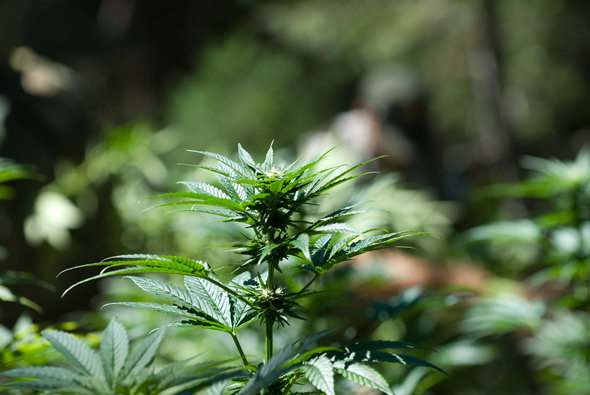The Six Biggest Drug Stories of 2016
The future for legal pot and drug reform is very much in doubt. North Cascades National Park / CC BY-NC-SA 2.0
North Cascades National Park / CC BY-NC-SA 2.0
By Phillip Smith / AlterNet
As 2016 comes to a tumultuous end, we look back on the year in drugs and drug policy. It’s definitely a mixed bag, with some major victories for drug reform, especially marijuana legalization, but also some major challenges, especially around heroin and prescription opioids, and the threat of things taking a turn for the worse next year.
Here are the six biggest stories from the year on drugs.
1. Marijuana legalization wins big. Pot legalization initiatives won in California, Maine, Massachusetts, and Nevada, losing only in Arizona. These weren’t the first states to do so—Colorado and Washington led the way in 2012, with Alaska, Oregon and Washington, D.C., following in 2014—but in one fell swoop, states with a combined population of nearly 50 million people just freed the weed. Add in the earlier states, and we’re now talking about around 67 million people, or more than one-fifth of the national population.
The question is, where does marijuana win next? We won’t see state legalization initiatives until 2018 (and the conventional wisdom is to wait for the higher-turnout 2020 presidential election year), and most of the low-hanging fruit in terms of initiative states has been harvested, but activists in Michigan came this close to qualifying for the ballot this year and are raring to go again. In the meantime, there are the state legislatures. When AlterNet looked into the crystal ball a few weeks ago, the best bets looked like Connecticut, Maryland, New Mexico, Rhode Island, and Vermont.
2. Medical marijuana wins big. Medical marijuana is even more popular than legal weed, and it went four-for-four at the ballot box in November, adding Arkansas, Florida, Montana, North Dakota to the list of full-blown medical marijuana states. That makes 28 states—more than half the country—that allow medical marijuana, along with another dozen or so red states that have passed limited CBD-only medical marijuana laws as a sop to public opinion.
It’s worth noting that Montana is a special case. Voters there approved medical marijuana in 2004, only to see a Republican-dominated state legislature gut the program in 2011. The initiative approved by voters this year reinstates that program, and shuttered dispensaries are now set to reopen.
The increasing acceptance of medical marijuana is going to make it that much harder for the DEA or the Trump administration to balk at reclassifying marijuana away from Schedule I, which is supposedly reserved for dangerous substances with no medical uses. It may also, along with the growing number of legal pot states, provide the necessary impetus to changing federal banking laws to allow pot businesses to behave like normal businesses.
3. Republicans take control in Washington. The Trump victory last month and looming Republican control of both houses of Congress has profound drug policy implications, for everything from legal marijuana to funding for needle exchange programs to sentencing policy to the border and foreign policy and beyond. Early Trump cabinet picks, such as Alabama Sen. Jeff Sessions (R) to lead the Justice Department, are ominous for progressive drug reform, but as with many other policy spheres, what Trump will actually do is a big unknown. It’s probably safe to say that any harm reduction programs requiring federal funding or approval are in danger, that any further sentencing reforms are unlikely and that any federal spending for mental health and substance abuse treatment will face an uphill battle. But the cops will probably get more money.
The really big question mark is around pot policy. Trump has signaled he’s okay with letting the states experiment, but Sessions is one of the most retrograde drug warriors in Washington. Time will tell, but in the meantime, the marijuana industry is on tenterhooks and respect for the will of voters in pot legal states and even medical marijuana states is an open question.
4. The opioid epidemic continues. Just as the year comes to an end, the CDC announced that opioid overdose deaths last year had topped 33,000, and with 12,000 heroin overdoses, junk had overtaken gunplay as a leading cause of death.
The crisis has provoked numerous responses, at both the state and the federal levels, some good, and some not. Just this month, Congress approved a billion dollars in opioid treatment and prevention programs. The overdose epidemic has also prompted the loosening of access to the opioid overdose reversal drug naloxone and prodded ongoing efforts to embrace more harm reduction approaches, such as supervised injection sites.
On the other hand, prosecutors in states across the country have taken to charging those who sell opioids (prescription or otherwise) to people who die of overdose with murder, more intrusive and privacy-invading prescription monitoring programs have been established, and the tightening of the screws on opioid prescriptions is leaving some chronic pain sufferers in the lurch and leading others to seek out opioids on the black market.
5. Obama commutes more than 1,000 drug war sentences. In a bid to undo some of the most egregious excesses of the drug war, President Obama has now cut the sentences of and freed more than 1,000 people sentenced under the harsh laws of the 1980s, particularly the racially biased crack cocaine laws, who have already served more time than they would have if sentenced under current laws passed during the Obama administration. He has commuted more sentences in a single year than any president in history and more sentences than the last 11 presidents combined.
The commutations come under a program announced by former Attorney General Eric Holder, who encouraged drug war prisoners to apply for them. The bad news is that the clock is going to run out before Obama has a chance to deal with thousands of pending applications backlogged in the Office of the Pardons Attorney. The good news is that he still has six weeks to issue more commutations and free more drug war prisoners.
6. DEA gets a wakeup call when it tries to ban kratom. Derived from a Southeast Asian tree, kratom has become popular as an unregulated alternative to opioids for relaxation and pain relief, as well as withdrawal from opioids. It has very low overdose potential compared to other opioids and has become a go-to drug for hundreds of thousands or even millions of people.
Perturbed by its rising popularity, the DEA moved in late summer to use its emergency scheduling powers to ban kratom, but was hit with an unprecedented buzzsaw of opposition from kratom users, scientists, researchers, and even Republican senators like Orrin Hatch (R-UT), who authored and encouraged his colleagues to sign a letter to the DEA asking the agency to postpone its planned scheduling.
The DEA backed off—but didn’t back down—in October, announcing it was shelving its ban plan for now and instead opening a period of public comment. That period ended December 1, but before it did, the agency was inundated with submissions from people opposing the ban. Now, the DEA will factor in that input, as well as formal input from the Food and Drug Administration before making its decision.
The battle around kratom isn’t over, and the DEA could still ban it in the end, but the whole episode demonstrates how much the ground has shifted under the agency. DEA doesn’t just get its way anymore.
Your support is crucial…With an uncertain future and a new administration casting doubt on press freedoms, the danger is clear: The truth is at risk.
Now is the time to give. Your tax-deductible support allows us to dig deeper, delivering fearless investigative reporting and analysis that exposes what’s really happening — without compromise.
Stand with our courageous journalists. Donate today to protect a free press, uphold democracy and unearth untold stories.









You need to be a supporter to comment.
There are currently no responses to this article.
Be the first to respond.